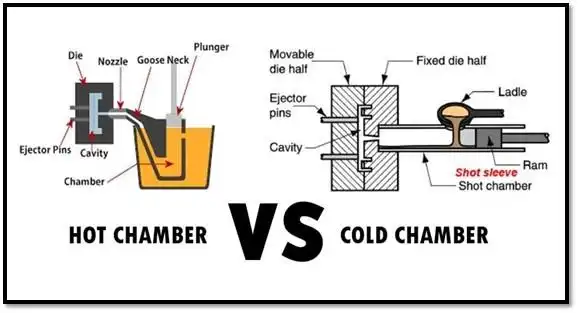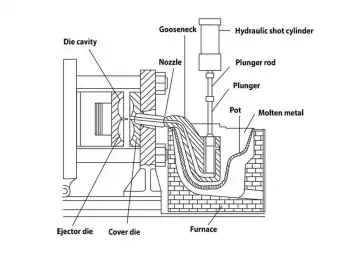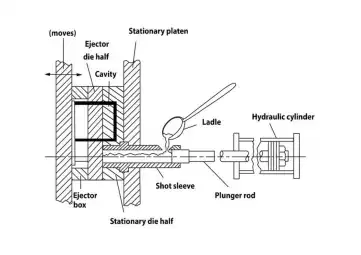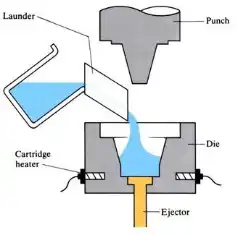
Knowledge
Die Casting Types

The two basic types of die casting machines are Hot chamber and Cold chamber machines. The variations on these two significant casting process types are vacuum, squeeze, low-pressure and semi-solid die casting. Different die casting processes are chosen over others depending on part material, geometry, size, and complexity.
Hot chamber process
The hot chamber process is sometimes known as the hot die or gooseneck casting process. In this process, the plunger and chamber of the injection mechanism are dipped in the molten metal bath of a metal furnace (Image below) and used for low melting point metals that don’t chemically attack the dipped plunger assembly.

With the dies closed, the plunger withdraws and opens the chamber port to allow the molten metal to flow into the chamber. Then the plunger seals the port while pushing the molten metal into the die cavity through the gooseneck and the nozzle. After entering the die cavity, the molten metal is held under pressure until it solidifies inside the die. The hot chamber process yields a much higher production rate than the cold chamber process because of the high pressure.
Hot chamber casting is better suited to dealing with metals with lower melting points, such as tin and zinc, as well as alloys.
Cold chamber process
In the cold chamber process, molten metal is poured into the shot sleeve or chamber part of the injection cylinder before pushing into the mould. Because the sleeve is not heated, the procedure is known as the cold chamber process. Since the metal melting pot is separate, it doesn’t have a corrosion problem.

The cold chamber process starts when molten material is transferred to the shot chamber from the furnace through the pouring hole. Then a hydraulic plunger seals the cold chamber port and forces the metal into the mould cavity at pressure. The pressure ranges between 30Mpa and 150 MPa.
This process is typically used for high-melting-point alloys of aluminium, magnesium, and copper, while other metals including ferrous metals can also be cast. Molten-metal temperatures begin at 600°C for aluminium and certain magnesium alloys and rise significantly for copper- and iron-based alloys.
Vacuum die casting
The vacuum die-casting process is an add-on for the two traditional die-casting methods and is most associated with a cold chamber process. A vacuum source removes the air and gases trapped within the die cavity before the molten metal enters the die cavity.This type of die casting minimizes turbulence and gas inclusions and is beneficial in applications intended for post-cast heat treatment.Some of the advantages of this casting type are improved mechanical properties, better surface finish, dimensional stability, shorter cycle time, reduced defects caused by the trapped gasses. The parts can also be heat treated
Squeeze casting process
Squeeze casting, also known as Liquid metal forging incorporates features from both casting and forging to make automotive components and mortar bodies. The image shows the operation sequence of the squeeze casting process, where the molten metal is squeezed into the mould while filling up the recessed regions of moulding, which offers hugely dense products at the end of the process. This method is also used to make reinforced metal matrix composites, in which molten aluminium infiltrates a fibre reinforcing structure.

Squeeze castings have reduced shrinkage and gas porosity, improved mechanical qualities due to small grain structure induced by quick solidification, and superior surface quality. Aluminium and magnesium alloys are frequently processed via squeeze casting.
Semi-solid metal forming
Semi-solid metal forming (SSM), also known as Semi-solid forming, semi-solid die-casting or mushy state processing is a type of die casting process that incorporates features of both casting and forging and uses semi-molten material.It is commonly used to make aluminium alloy parts for aerospace, pressure containment, military, engine mounts and blocks, and oil pump filter housings.They can produce complex parts with thin walls, excellent mechanical properties, superior surface finish, comparably reduced porosity and tight tolerance. They can also be heat treated. One of the disadvantages is that the process is extremely susceptible to environmental factors such as temperature hence manufacturing equipment and the environment needs more control which leads to expensive equipment.
Welcome to contact VIGOR for more details. Please feel free to call us at 029 81161513 or email us at info@castings-forging.com



